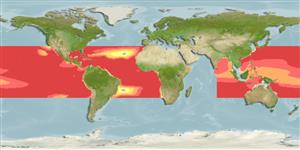>
Myctophiformes (Lanternfishes) >
Myctophidae (Lanternfishes) > Diaphinae
Etymology: Diaphus: Greek, dis, dia = through + Greek, physa, phyo = to beget, to have as offspring (Ref. 45335).
Environment: milieu / climate zone / depth range / distribution range
Ecología
marino batipelágico; oceanodromo (Ref. 51243); rango de profundidad 100 - 560 m (Ref. 4479). Deep-water; 35°N - 27°S
Eastern Atlantic: Congo to Namibia. Western Atlantic: 15°N to the Subtropical Convergence (rare in the minimum region off Brazil). Eastern Pacific: near Hawaii. Western Pacific: Japan, New Zealand and Australia (Ref. 7300).
Length at first maturity / Tamaño / Peso / Age
Maturity: Lm ?, range 3 - ? cm
Max length : 3.2 cm SL macho / no sexado; (Ref. 4479)
Short description
Claves de identificación | Morfología | Morfometría
Espinas dorsales (total) : 0; Radios blandos dorsales (total) : 12 - 14; Espinas anales: 0; Radios blandos anales: 12 - 14.
Oceanic and mesopelagic, found in 300-560 m during the day (Ref. 4066) and 60-175 m at night (Ref. 47377). Specimens reach sexual maturity at a length of 2,7 cm.
Life cycle and mating behavior
Maturities | Reproducción | Spawnings | Egg(s) | Fecundities | Larva
Masuda, H., K. Amaoka, C. Araga, T. Uyeno and T. Yoshino, 1984. The fishes of the Japanese Archipelago. Vol. 1. Tokai University Press, Tokyo, Japan. 437 p. (text). (Ref. 559)
IUCN Red List Status (Ref. 130435)
Threat to humans
Harmless
Human uses
Herramientas
Special reports
Download XML
Fuentes de Internet
Estimates based on models
Preferred temperature (Ref.
123201): 11.1 - 21.4, mean 15.4 °C (based on 339 cells).
Phylogenetic diversity index (Ref.
82804): PD
50 = 0.5000 [Uniqueness, from 0.5 = low to 2.0 = high].
Bayesian length-weight: a=0.01000 (0.00436 - 0.02294), b=3.04 (2.86 - 3.22), in cm total length, based on LWR estimates for this Genus-body shape (Ref.
93245).
Nivel trófico (Ref.
69278): 3.1 ±0.3 se; based on size and trophs of closest relatives
Resiliencia (Ref.
120179): Alto, población duplicada en un tiempo mínimo inferior a 15 meses (Preliminary K or Fecundity.).
Fishing Vulnerability (Ref.
59153): Low vulnerability (10 of 100).
